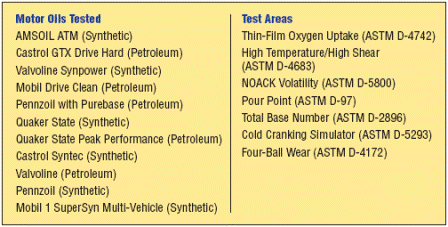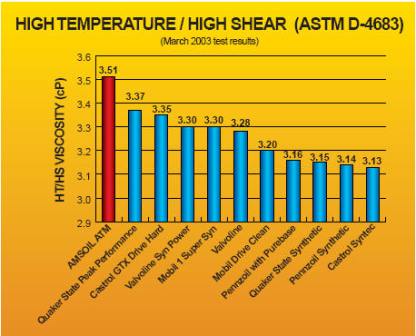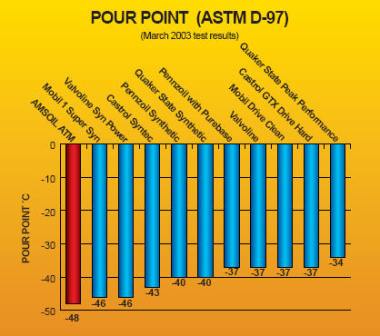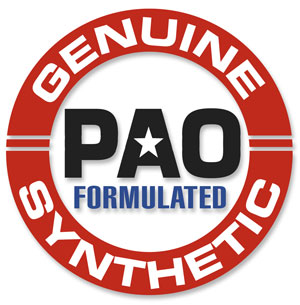
API
Motor Oil Testing:
AMSOIL Synthetic 10W-30 Motor
Oil (ATM) and 10 competing
conventional and synthetic
10W-30 motor oils were subjected
to a series of API motor oil
tests. The competing oils
included petroleum-based Castrol
GTX Drive Hard, Mobil Drive
Clean, Pennzoil with Purebase,
Quaker State Peak Performance
and Valvoline, as well as
synthetic-based Valvoline
Synpower, Quaker State, Castrol
Syntec, Pennzoil and Mobil 1
SuperSyn Multi-Vehicle.

Seven API tests were run on the
motor oils. The Thin-Film Oxygen
Uptake Test (TFOUT) measures the
oxidation stability of engine
oils. The High Temperature/High
Shear Test (HTHS) measures a
lubricantís viscosity under
severe operating conditions. The
NOACK Volatility Test measures
the evaporation loss of oils in
high temperature service. Pour
Point indicates the lowest
temperature at which a fluid
will flow. Total Base Number (TBN)
is the measurement of a
lubricantís reserve alkalinity
for combating acids. The Cold
Cranking Simulator Test (CCS)
measures a lubricantís viscosity
at low temperatures and high
shear rates. The Four-Ball Wear
Test measures a lubricantís wear
protection properties. The
impressive test results show
AMSOIL Synthetic 10W-30 Motor
Oil outperformed the competitors
in each test.
Thin-Film Oxygen Uptake (ASTM
D-4742):
The Thin-Film Oxygen Uptake Test
evaluates the oxidation
stability of lubricating oils. A
mixture of the test oil and
chemistries found in gasoline
engine operation
(oxidized/nitrated fuel, soluble
metals and distilled water) are
placed in a test vessel, which
is pressurized with oxygen and
placed in a heated bath.
Anti-oxidant breakdown is
evident when the oxygen pressure
in the vessel rapidly decreases.
At this point, the induction
time (break point) of the oil is
recorded. As shown in the graph,
AMSOIL Synthetic 10W-30 Motor
Oil had the highest induction
time of all the tested oils. In
fact, it didnít reach its break
point in over 500 minutes of
testing.
The superior oxidation stability
of AMSOIL Synthetic 10W-30 Motor
Oil allows it to effectively
resist the formation of engine
deposits and sludge, keeping
engines running clean and
efficient and extending oil
life. It also resists
thickening, maintaining its
superior wear protection and
lubricating properties and
maximizing fuel efficiency.

High
Temperature/High Shear (ASTM
D-4683):
The High Temperature/High Shear
Test measures a lubricantís
viscosity under severe high
temperature and shear conditions
that resemble highly-loaded
journal bearings in fired
internal combustion engines. In
order to prevent bearing wear,
it is important for a lubricant
to maintain its protective
viscosity under severe operating
conditions. The minimum High
Temperature/High Shear viscosity
for a 30 weight oil is 2.9 cP.
As shown in the graph, AMSOIL
Synthetic 10W-30 Motor Oil
surpasses this minimum standard
and displayed the highest High
Temperature/High Shear viscosity
in the group.
The superior viscosity retention
of AMSOIL Synthetic 10W-30 Motor
Oil in the face of severe
temperature and shear conditions
allows it to provide continuous,
unsurpassed protection for
engine bearings, extending
equipment life and preventing
wear.

NOACK
Volatility (ASTM D-5800):
The NOACK Volatility Test
determines the evaporation loss
of lubricants in high
temperature service.The more
motor oils vaporize, the thicker
and heavier they become,
contributing to poor
circulation, reduced fuel
economy and increased oil
consumption, wear and emissions.
A maximum of 15 percent
evaporation loss is allowable to
meet API SL and ILSAC GF-3
specifications. As shown in the
graph, AMSOIL Synthetic 10W-30
Motor Oil outperformed its
nearest competitor by over 30
percent.
The extremely low volatility of
AMSOIL Synthetic 10W-30 Motor
Oil allows it to maintain its
superior protective and
performance qualities throughout
extended drain intervals, even
when faced with severe operating
temperatures. In addition, oil
consumption and emissions are
minimized and fuel efficiency is
maximized.

Pour
Point (ASTM D-97):
The Pour Point Test determines
the lowest temperature at which
a lubricant will flow when
cooled under prescribed
conditions. The lower a
lubricantís pour point, the
better protection it provides in
low temperature service. As
shown in the graph, AMSOIL
Synthetic 10W-30 Motor Oil has
the lowest pour point of the
tested oils.
The low pour point of AMSOIL
Synthetic 10W-30 Motor Oil
allows it to maintain its
fluidity in extremely low
temperatures, reducing drag on
moving vehicle parts, providing
critical engine components with
quick, essential lubrication and
easing startup in cold
temperatures. Wear is greatly
reduced and equipment life is
extended.

Total
Base Number (ASTM D-2896):
Total Base Number (TBN) is the
measurement of a lubricantís
reserve alkalinity, which aids
in the control of acids formed
during the combustion process.
The higher a motor oilís TBN,
the more effective it is in
suspending wear-causing
contaminants and reducing the
corrosive effects of acids over
an extended period of time. As
shown in the graph, AMSOIL
Synthetic 10W-30 Motor Oil has
the highest TBN of the tested
oils.
The high TBN of AMSOIL Synthetic
10W-30 Motor Oil allows it to
effectively combat wear-causing
contaminants and acids,
providing superior protection
and performance over extended
drain intervals.

Cold
Crank Simulator (ASTM D-5293):
The Cold Crank Simulator Test
determines the apparent
viscosity of lubricants at low
temperatures and high shear
rates. Viscosity of lubricants
under these conditions is
directly related to engine
cranking and startability. The
lower a lubricantís cold crank
viscosity, the easier an engine
will turn over in cold
temperatures. 10W motor oils are
tested at -25įC and must have a
viscosity below 7000 cP to pass.
As shown in the graph, AMSOIL
Synthetic 10W-30 Motor Oil is
well below the maximum
requirement, while many of the
competing oils barely pass.
The low cold crank viscosity of
AMSOIL Synthetic 10W-30 Motor
Oil reduces drag on moving
engine parts and allows engines
to achieve critical cranking
speed in extremely frigid
temperatures. Engines turn over
quickly and dependably in the
coldest winter temperatures.

Four
Ball Wear (ASTM D-4172):
The Four Ball Wear Test
determines the wear protection
properties of a lubricant. Three
metal balls are clamped together
and covered with the test
lubricant, while a rotating
fourth ball is pressed against
them in sliding contact. This
contact typically produces a
wear scar, which is measured and
recorded. The smaller the
average wear scar, the better
the wear protection provided by
the lubricant. As shown in the
graph, AMSOIL Synthetic 10W-30
Motor Oil produced the smallest
wear scar of the tested
lubricants.
AMSOIL Synthetic 10W-30 Motor
Oil provides unsurpassed
protection against engine wear.
Equipment life is extended, and
repairs, downtime and expenses
are reduced.

 AMSOIL
INC. has been the leader in
synthetic motor oil formulation
since its introduction of the
worldís first API rated
synthetic motor oil in 1972. By
specializing exclusively in
synthetic lubricant technology,
AMSOIL is able to optimize the
most advanced chemistries
available. The ďGenuine
Synthetic PAO FormulatedĒ
designation displayed on AMSOIL
packaging indicates that the
oils are formulated with
Polyalphaolefin (PAO) synthetic
base stocks. This chemistry is
the industryís premier base
stock technology. Unlike
conventional mineral-based
chemistries, AMSOIL PAO base
stocks contain fully saturated,
hydrogenated molecules and are
free of wax and other
impurities. Combined with an
exact balance of premium
additives, it delivers superior
hot and cold temperature
performance, resists oxidation
and acid formation and provides
long-term wear protection.
AMSOIL ďGenuine Synthetic PAO
FormulatedĒ oils have shattered
the parameters of the most
rigorous industry testing and
set the standard for all other
motor oils.
AMSOIL
INC. has been the leader in
synthetic motor oil formulation
since its introduction of the
worldís first API rated
synthetic motor oil in 1972. By
specializing exclusively in
synthetic lubricant technology,
AMSOIL is able to optimize the
most advanced chemistries
available. The ďGenuine
Synthetic PAO FormulatedĒ
designation displayed on AMSOIL
packaging indicates that the
oils are formulated with
Polyalphaolefin (PAO) synthetic
base stocks. This chemistry is
the industryís premier base
stock technology. Unlike
conventional mineral-based
chemistries, AMSOIL PAO base
stocks contain fully saturated,
hydrogenated molecules and are
free of wax and other
impurities. Combined with an
exact balance of premium
additives, it delivers superior
hot and cold temperature
performance, resists oxidation
and acid formation and provides
long-term wear protection.
AMSOIL ďGenuine Synthetic PAO
FormulatedĒ oils have shattered
the parameters of the most
rigorous industry testing and
set the standard for all other
motor oils.